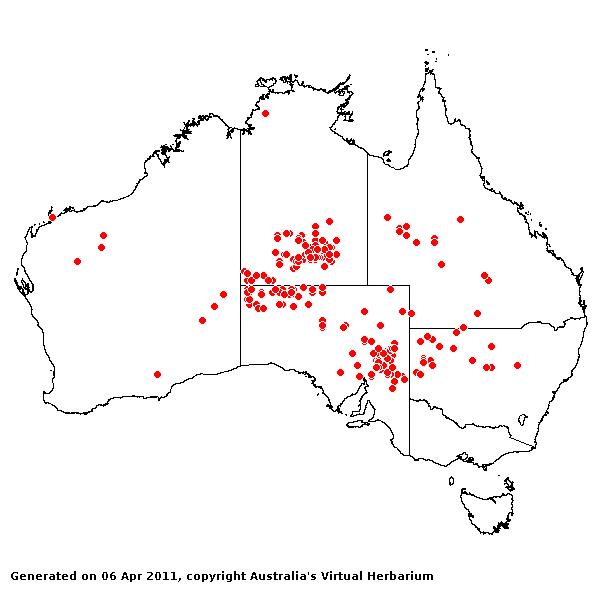Aristida nitidula (Henrard)S.T.Blake
ex J.M.Black. Fl. South Australia
Ed.2,1: 83 (1943).
Classification. (GPWG 2001) : Subfamily
Aristidoideae. Aristideae.
Basionym and/or
Replacement Name: Aristida
nitidula (Henrard) S.T. Blake ex Black, Trans. & Proc. Roy. Soc.
South Australia
67: 46 (1943).
Type of Basionym or
Protologue Information: HT: Kempe 4, 1879, Australia: Northern
Territory: Central Southern Station, Mission,
Finke River (L (photo, BRI); IT: K, MEL).
T: H.J. Kempe 28,
1879, Australia: Northern Territory, Finke River
(L).
Key references
(books and floras): [1952] C.A.Gardner, Flora of Western Australia 1
Gramineae (166), [1981] M.Lazarides in J.Jessop (ed)., Flora of
Central Australia (450), [2002] D.Sharp & B.K.Simon, AusGrass,
Grasses of Australia, [2006] J.Jessop, G.R.M.Dashorst, F.M.James, Grasses
of South Australia (326), [2008] S.W.L.Jacobs, R.D.B.Walley &
D.J.B.Wheeler, Grasses of New South Wales (130).
Illustrations:
[1983] J.C.Tothill & J.B.Hacker, Grasses of Southern Queensland
(106(31)), [2005] K.Mallet (ed.), Flora of Australia 44B: Poaceae 3
(Fig. 119A-B), [2006] J.Jessop, G.R.M.Dashorst, F.M.James, Grasses of South
Australia (327, Fig. 259), [2008]
S.W.L.Jacobs, R.D.B.Whalley & D.J.B.Wheeler, Grasses of New South Wales,
4th edn (130).
Derivation: L. niteo,
shine; -ula, exhibiting tendency. Spikelets glossy.
Habit.
Perennial. Culms 35–82 cm tall, 1 mm diam., 1 -noded. Mid-culm internodes
glabrous. Lateral branches simple. Leaf-sheaths antrorsely scabrous. Ligule a
fringe of hairs, 0.5–1 mm long. Leaf-blades straight, conduplicate or involute
or convolute, 12–17 cm long, 0.7–1 mm wide. Leaf-blade surface scaberulous.
Inflorescence.
Inflorescence compound, a panicle. Panicle linear, 12–28 cm long, 0.5–2 cm
wide.
Spikelets.
Spikelets pedicelled. Fertile spikelets 1-flowered, comprising 1 fertile
floret(s), without rachilla extension, lanceolate, terete, 6.3–10.6 mm long.
Glumes.
Glumes similar, thinner than fertile lemma. Lower glume lanceolate, membranous,
keeled, 1-keeled, 1 -nerved. Lower glume surface glabrous. Lower glume apex
muticous or mucronate. Upper glume lanceolate, 6.2–9.6 mm long, membranous,
keeled, 1-keeled, 1 -nerved. Upper glume surface smooth to scabrous, glabrous.
Upper glume apex entire, muticous or mucronate.
Florets.
Fertile lemma 6–10 mm long, without keel, 3 -nerved. Lemma apex awned, 3
-awned. Median (principal) awn without a column. Lateral lemma awns present.
Palea without keels. Anthers 3. Grain 4.6–6 mm long.
Continental
Distribution: Australasia.
Australian
Distribution: Western Australia, Northern Territory, South Australia,
Queensland, New South Wales.
Western Australia: Fortescue,
Ashburton, Carnarvon. Northern Territory:
Central Australia North, Central Australia
South. South Australia: North-western,
Lake Eyre, Flinders
Ranges, Eastern. Queensland:
Burke, Gregory North, Warrego, Mitchell. New
South Wales: North-Western Plains, North Far
Western Plains.
Notes.
A. nitidula is very similar to A. arida except that the glumes
are subequal.
Mainly occurs in
central Australia and the
Lake Eyre region, but also in all mainland states except Victoria. Acacia (especially mulga - Acacia
aneura) communities on rocky and sandy soils. Flowering and fruiting all
year.





